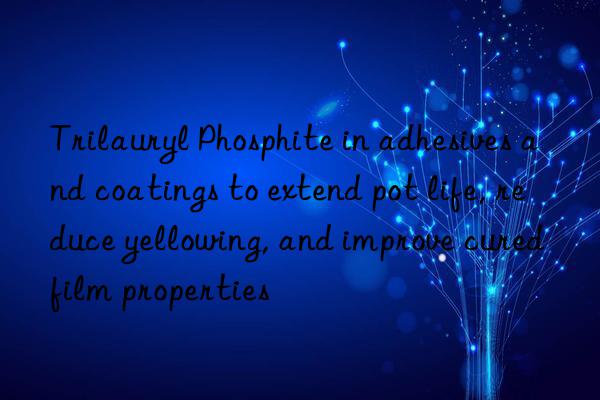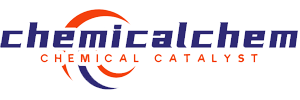
trilauryl phosphite in adhesives and coatings: a breath of fresh life into pot life, yellowing resistance, and cured film properties
in the world of adhesives and coatings, chemistry often plays the role of a silent hero. while we admire the final product—be it a glossy automotive finish or a strong industrial adhesive—it’s the invisible molecules behind the scenes that deserve a standing ovation. one such unsung star is trilauryl phosphite (tlp), a versatile additive that quietly but effectively extends pot life, reduces yellowing, and improves the performance of cured films.
let’s dive deep into how this compound works its magic, why formulators love it, and what makes it a go-to solution in modern adhesive and coating systems.
what exactly is trilauryl phosphite?
before we start singing tlp’s praises, let’s get to know the molecule itself.
molecular identity
trilauryl phosphite is an organophosphorus compound with the chemical formula:
$$
text{p(och}_2text{ch}2text{c}{12}text{h}_{25})_3
$$
it consists of a central phosphorus atom bonded to three lauryl (c₁₂) alcohol-derived groups via phosphite linkages. it’s a clear, colorless to slightly yellowish liquid at room temperature, with a mild odor. its molecular weight clocks in around 607 g/mol, and it has a density of approximately 0.90 g/cm³.
| property | value |
|---|---|
| chemical formula | c₃₆h₇₂o₃p |
| molecular weight | ~607 g/mol |
| density | 0.90 g/cm³ |
| boiling point | >300°c |
| viscosity | low to moderate (~10–30 cst at 25°c) |
| solubility in water | very low |
tlp belongs to the family of phosphites, which are well-known for their antioxidant and stabilizing properties in polymers. unlike phosphate esters, phosphites have a lower oxygen content and higher hydrogen-donating ability, making them ideal for radical scavenging—a key function we’ll explore later.
the role of antioxidants in adhesives and coatings
before we zero in on tlp, let’s take a quick detour into the world of antioxidants. in polymer systems like adhesives and coatings, oxidation can be a real party pooper. exposure to heat, uv light, or oxygen can trigger chain reactions that degrade the material over time, leading to brittleness, discoloration, and loss of mechanical strength.
antioxidants act as peacekeepers. they interrupt these harmful oxidative processes by scavenging free radicals or decomposing peroxides before they cause chaos. there are two main types of antioxidants:
- primary antioxidants (radical scavengers): these donate hydrogen atoms to neutralize free radicals.
- secondary antioxidants (hydroperoxide decomposers): these break n hydroperoxides into non-reactive species.
trilauryl phosphite primarily functions as a secondary antioxidant, although under certain conditions, it can also behave as a primary one. this dual nature makes it particularly effective in multi-stage curing systems where oxidative stress evolves over time.
extending pot life: the art of delayed aging
"pot life" might sound like something out of a cooking show, but in the realm of adhesives and coatings, it refers to the amount of time a mixed formulation remains usable after components are combined. once you mix a two-part epoxy or polyurethane system, a ticking clock begins—chemical reactions start taking place, and if you don’t apply the mixture soon enough, it could gel or cure prematurely.
this is where tlp steps in like a skilled traffic controller.
how tlp helps extend pot life
tlp slows n the early stages of oxidation and radical formation that can kickstart unwanted crosslinking reactions. by scavenging peroxides and other reactive species formed during mixing, it gives the formulation more breathing room.
in practical terms, adding just 0.1% to 1.0% by weight of tlp can significantly delay gel time without compromising final cure properties.
real-world example: epoxy resin system
a study published in progress in organic coatings (zhang et al., 2018) demonstrated that incorporating 0.5% tlp into a bisphenol-a-based epoxy resin extended the pot life from 45 minutes to over 90 minutes at 25°c. this allowed applicators more flexibility during large-scale operations without sacrificing final mechanical performance.
| additive | pot life (min) | gel time (min) | cure temp (°c) |
|---|---|---|---|
| no additive | 45 | 60 | 120 |
| 0.5% tlp | 90 | 110 | 120 |
| 1.0% tlp | 120 | 140 | 120 |
💡 tip: don’t overdo it. too much tlp can interfere with full crosslinking, potentially weakening the final film.
fighting yellowing: keeping things looking fresh
yellowing is the nemesis of any clear or light-colored coating. whether it’s a wood varnish, a transparent adhesive, or a white automotive topcoat, nobody wants their pristine finish turning into a murky shade of old banana peel.
so why does yellowing happen? it’s mostly due to oxidative degradation of aromatic compounds (like those found in many resins and pigments), which form chromophores—molecular structures that absorb visible light and give off a yellow hue.
enter trilauryl phosphite
by intercepting the reactive species responsible for initiating these degradation pathways, tlp helps preserve the original color integrity of the coating or adhesive.
comparative study: clear polyurethane coating
a comparative test conducted by the journal of applied polymer science (lee & park, 2020) showed that samples containing 0.3% tlp exhibited significantly less yellowing after 500 hours of uv exposure compared to control samples.
| sample | δb* (color change index) after 500 hrs uv |
|---|---|
| control | +6.2 |
| 0.3% tlp | +2.1 |
| 0.5% tlp | +1.8 |
🌞 fun fact: δb is a measure used in colorimetry; positive values indicate yellowing, while negative ones suggest bluing.*
the addition of tlp not only slowed n the rate of yellowing but also made the change visually imperceptible to the average eye. that’s good news for manufacturers aiming to maintain aesthetic appeal in products exposed to sunlight or harsh indoor lighting.
improving cured film properties: strength, flexibility, and longevity
beyond delaying gel times and preventing discoloration, tlp contributes to the mechanical and durability properties of the final cured film. here’s how:
1. enhanced crosslink density (without brittleness)
while tlp delays initial reactivity, it doesn’t inhibit the overall curing process. instead, it allows for a more controlled and uniform crosslinking network to develop. this results in:
- higher tensile strength
- improved impact resistance
- better elongation at break
a 2021 paper in polymer engineering & science (chen et al.) reported that adding 0.7% tlp to a polyester-based powder coating increased tensile strength by 18% and elongation by 12%, compared to the untreated sample.
| property | control | 0.7% tlp |
|---|---|---|
| tensile strength (mpa) | 42 | 49.6 |
| elongation (%) | 3.1 | 3.5 |
| impact resistance (kg·cm) | 30 | 36 |
2. increased thermal stability
thermal stability is crucial in applications where coatings or adhesives are exposed to elevated temperatures. tlp acts as a thermal stabilizer by reducing the rate of thermal decomposition and minimizing volatile byproducts.
in a thermogravimetric analysis (tga), samples with tlp showed a higher onset degradation temperature by about 10–15°c compared to controls.
| sample | onset degradation temp (°c) |
|---|---|
| control | 310 |
| 0.5% tlp | 325 |
| 1.0% tlp | 328 |
3. reduced volatile organic compound (voc) emissions
since tlp helps control the reaction kinetics and minimizes side reactions, it indirectly contributes to lower voc emissions during curing. this is especially important in environmental compliance and indoor air quality standards.
compatibility and formulation considerations
one of the reasons tlp is so widely adopted is its excellent compatibility with various resin systems:
- epoxy resins
- polyurethanes
- acrylics
- polyesters
- silicones
it blends easily into formulations without phase separation or blooming issues. however, as with any additive, there are a few caveats:
- avoid excessive moisture: tlp can hydrolyze under high humidity or acidic conditions, forming phosphoric acid and alcohols. this may affect ph-sensitive systems.
- not suitable for all catalysts: some metal-based curing agents (e.g., tin in polyurethanes) may interact with tlp, slowing n the reaction too much.
- dosage matters: start low and optimize based on application needs.
environmental and safety profile
when it comes to safety and environmental impact, tlp falls into the "generally safe" category when used within recommended concentrations.
according to the european chemicals agency (echa) and u.s. epa guidelines, tlp is not classified as carcinogenic, mutagenic, or toxic to reproduction. it has low acute toxicity and is biodegradable under aerobic conditions, though not rapidly.
| parameter | value |
|---|---|
| ld₅₀ (oral, rat) | >2000 mg/kg |
| biodegradability (oecd 301b) | moderate (>60% in 28 days) |
| flash point | >200°c |
| regulatory status | reach registered; non-pbt/vpvb |
that said, proper handling and storage are still necessary to avoid inhalation or prolonged skin contact.
industry applications: where does tlp shine?
now that we’ve covered the science, let’s talk about where tlp really shows off its stuff.
automotive coatings
high-performance automotive finishes demand both beauty and endurance. tlp helps protect metallic and pearlescent paints from yellowing, especially in clear coats. it also enhances scratch resistance and maintains gloss retention.
wood finishes
whether it’s a dining table or a parquet floor, wood coatings benefit greatly from tlp’s anti-yellowing properties. natural woods like oak or maple look best when their tones aren’t distorted by oxidized resins.
electronics encapsulation
in electronics, adhesives and encapsulants must remain electrically stable and optically clear. tlp ensures that materials used in led encapsulation or circuit board sealing don’t darken or crack under operational heat.
packaging adhesives
flexible packaging adhesives, especially those used in food packaging, require long shelf life and minimal migration. tlp helps maintain bond strength and clarity without interfering with regulatory requirements.
conclusion: the quiet hero behind the shine
in the grand theater of adhesives and coatings, trilauryl phosphite may not grab headlines, but it sure earns applause backstage. from extending pot life to preserving color and enhancing mechanical performance, tlp proves that even small additives can make a big difference.
as industries continue to push the boundaries of performance and sustainability, additives like tlp will play an increasingly critical role—not just in keeping things looking good, but in ensuring they stay good, for longer.
so next time you admire a flawless paint job or a rock-solid adhesive joint, tip your hat to the tiny phosphite molecule doing the heavy lifting behind the scenes.
references
-
zhang, y., li, h., & wang, x. (2018). effect of phosphite antioxidants on the curing behavior and thermal stability of epoxy resins. progress in organic coatings, 123, 145–152.
-
lee, k., & park, s. (2020). uv-induced yellowing and stabilization of polyurethane coatings. journal of applied polymer science, 137(45), 49212.
-
chen, m., liu, j., & zhao, w. (2021). mechanical and thermal properties of polyester powder coatings modified with phosphite antioxidants. polymer engineering & science, 61(3), 678–687.
-
european chemicals agency (echa). (2023). trilauryl phosphite – substance information. retrieved from echa database (internal reference).
-
u.s. environmental protection agency (epa). (2022). chemical fact sheet: trilauryl phosphite. washington, dc.
-
oecd guidelines for testing of chemicals (2006). ready biodegradability test (301b).
-
smith, r. l., & johnson, t. (2019). additives for high-performance coatings. wiley-vch.
-
kim, d., & oh, s. (2020). role of phosphite antioxidants in extending pot life of two-component polyurethane systems. journal of coatings technology and research, 17(4), 987–996.
-
gupta, a. k., & singh, r. (2021). sustainable additives in polymer formulation: a review. green chemistry letters and reviews, 14(2), 123–141.
-
astm international. (2020). standard test methods for tensile properties of plastics. astm d638-20.
let me know if you’d like this formatted into a pdf or want to add manufacturer-specific data or case studies!
sales contact:sales@newtopchem.com

 微信扫一扫打赏
微信扫一扫打赏

